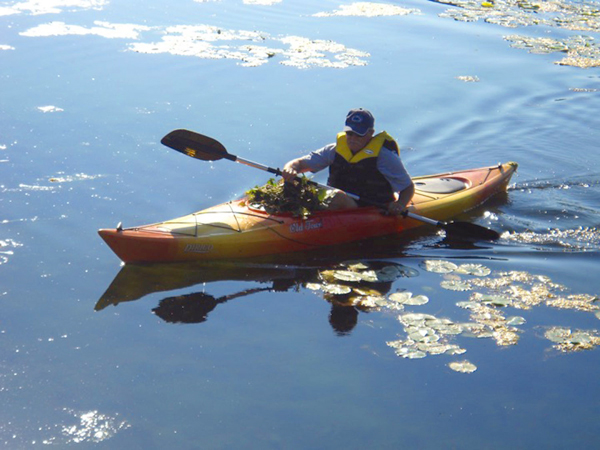By New York Sea Grant Launch Steward Nick Spera
New York Sea Grant 2012 Launch Stewards Program
Contact: Mary Penney, NY Sea Grant, E:
mp357@cornell.edu, P:315-312-3042
Oneida Lake is much more than just a lake. It is a place to relax on a boat, catch fish, go swimming at the local beach, or just sit on your deck and enjoy the view. Being such a recreational attraction, the lake often sees boat traffic from other waterways. This can introduce unwanted plant species that can become problematic for not just the ecosystem, but for boaters, fishermen, recreational users, and property owners.
Some invasive species may flourish to the extent of forming dense mats and root systems that cover large areas of water.
Trapa Natans, more commonly known as water chestnut, is one of these unwanted invasive species. Water chestnut can quickly obstruct native species habitat and recreationways.
In 1999, President William Clinton signed Executive Order 13112 that created a National Invasive Species Council (NISC) and defined the term invasive species as “an alien [non-native] species whose introduction does or is likely to cause economic or environmental harm or harm to human health.”
According to Cornell University Extension Invasive Species Specialist Charles O’Neill, a past member of the NISC Communication and Outreach Committee, “The water chestnut is native to Europe, Asia, and Africa. In its native habitat, the plant is kept in check by native insect parasites. These insects are not present in North America and the plant, once released into the wild, is free to reproduce rapidly.”
In Oneida Lake, the natural enemies of water chestnut are not present, so the plant thrives.
In recent years, local citizens in the Oneida Lake Rotary Club have participated in hand pulling the invaders and have made a great difference in controlling the population in the lake. The majority of the growth on the west end of the lake near the mouth of the Oneida River has been reduced to a more controllable level through the locally organized weed pulls.
On July 11, 2012, the Oneida Lake Rotary Club, in partnership with New York Sea Grant and with local volunteers with the Oneida Lake Association, held a water chestnut pull at Big Bay Creek and the mouth of Oneida River to remove the existing water chestnuts and help reduce their numbers. More than 350 pounds of water chestnuts were removed from the waters.
New York Sea Grant Launch Stewards spoke to the participants about aquatic invasive species control measures and about how to compost the water chestnuts into an organic fertilizer.
Throughout the summer months, New York Sea Grant Launch Stewards will be at area boat launches to educate boaters on how to inspect vessels and properly identify and dispose of water chestnuts and other invasive species. Also watch for other local events to help maintain the health of Oneida Lake.
For O’Neill’s fact sheet on water chestnut and information on other aquatic invasive species (AIS), see the Web site at
www.nyseagrant.org/ais.
For more information on the local launch steward program, please contact NYSG at 315-312-3042,
SGOswego@cornell.edu.

An Oneida Lake Rotary member brings water chestnuts he has hand pulled to the shore for offload. The volunteers collected more than 350 lbs. of the invasive species at their mid-July event;
photo: NYSG Launch Steward Nick Spera.
This is the third in a series of articles by the New York Sea Grant Launch Stewards. The stewards are college students helping to educate water users and shoreline property owners about how they can help slow the spread of aquatic invasive species. The Launch Stewards located along Oneida Lake, the eastern shore of Lake Ontario, and at the Salmon River Reservoir are part of a statewide project. Learn more online at www.nyseagrant.org/ccd.